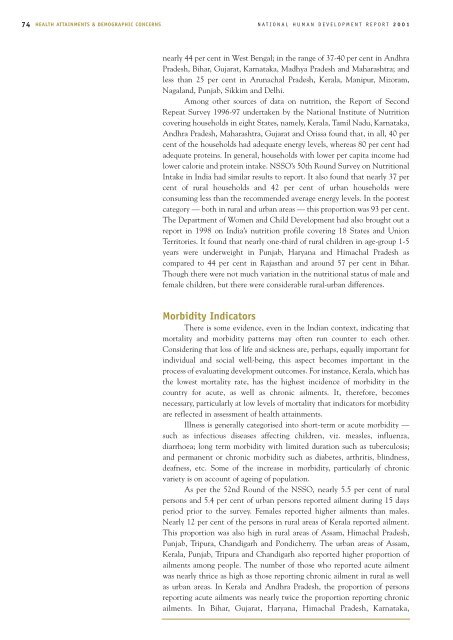National Human Development Report: 2001 - Indira Gandhi Institute ...
National Human Development Report: 2001 - Indira Gandhi Institute ...
National Human Development Report: 2001 - Indira Gandhi Institute ...
- No tags were found...
You also want an ePaper? Increase the reach of your titles
YUMPU automatically turns print PDFs into web optimized ePapers that Google loves.
74HEALTH ATTAINMENTS & DEMOGRAPHIC CONCERNSNATIONAL HUMAN DEVELOPMENT REPORT <strong>2001</strong>nearly 44 per cent in West Bengal; in the range of 37-40 per cent in AndhraPradesh, Bihar, Gujarat, Karnataka, Madhya Pradesh and Maharashtra; andless than 25 per cent in Arunachal Pradesh, Kerala, Manipur, Mizoram,Nagaland, Punjab, Sikkim and Delhi.Among other sources of data on nutrition, the <strong>Report</strong> of SecondRepeat Survey 1996-97 undertaken by the <strong>National</strong> <strong>Institute</strong> of Nutritioncovering households in eight States, namely, Kerala, Tamil Nadu, Karnataka,Andhra Pradesh, Maharashtra, Gujarat and Orissa found that, in all, 40 percent of the households had adequate energy levels, whereas 80 per cent hadadequate proteins. In general, households with lower per capita income hadlower calorie and protein intake. NSSO’s 50th Round Survey on NutritionalIntake in India had similar results to report. It also found that nearly 37 percent of rural households and 42 per cent of urban households wereconsuming less than the recommended average energy levels. In the poorestcategory — both in rural and urban areas — this proportion was 93 per cent.The Department of Women and Child <strong>Development</strong> had also brought out areport in 1998 on India’s nutrition profile covering 18 States and UnionTerritories. It found that nearly one-third of rural children in age-group 1-5years were underweight in Punjab, Haryana and Himachal Pradesh ascompared to 44 per cent in Rajasthan and around 57 per cent in Bihar.Though there were not much variation in the nutritional status of male andfemale children, but there were considerable rural-urban differences.Morbidity IndicatorsThere is some evidence, even in the Indian context, indicating thatmortality and morbidity patterns may often run counter to each other.Considering that loss of life and sickness are, perhaps, equally important forindividual and social well-being, this aspect becomes important in theprocess of evaluating development outcomes. For instance, Kerala, which hasthe lowest mortality rate, has the highest incidence of morbidity in thecountry for acute, as well as chronic ailments. It, therefore, becomesnecessary, particularly at low levels of mortality that indicators for morbidityare reflected in assessment of health attainments.Illness is generally categorised into short-term or acute morbidity —such as infectious diseases affecting children, viz. measles, influenza,diarrhoea; long term morbidity with limited duration such as tuberculosis;and permanent or chronic morbidity such as diabetes, arthritis, blindness,deafness, etc. Some of the increase in morbidity, particularly of chronicvariety is on account of ageing of population.As per the 52nd Round of the NSSO, nearly 5.5 per cent of ruralpersons and 5.4 per cent of urban persons reported ailment during 15 daysperiod prior to the survey. Females reported higher ailments than males.Nearly 12 per cent of the persons in rural areas of Kerala reported ailment.This proportion was also high in rural areas of Assam, Himachal Pradesh,Punjab, Tripura, Chandigarh and Pondicherry. The urban areas of Assam,Kerala, Punjab, Tripura and Chandigarh also reported higher proportion ofailments among people. The number of those who reported acute ailmentwas nearly thrice as high as those reporting chronic ailment in rural as wellas urban areas. In Kerala and Andhra Pradesh, the proportion of personsreporting acute ailments was nearly twice the proportion reporting chronicailments. In Bihar, Gujarat, Haryana, Himachal Pradesh, Karnataka,

















